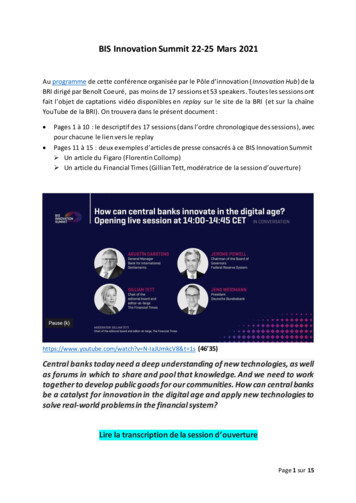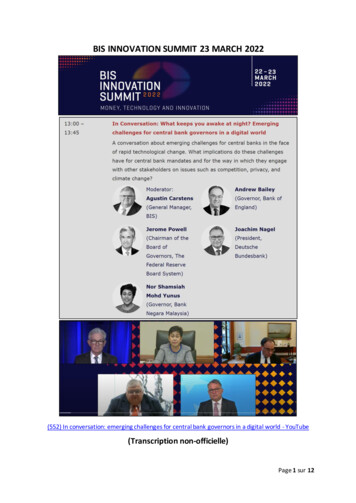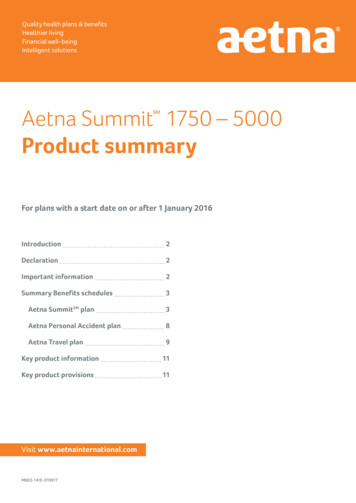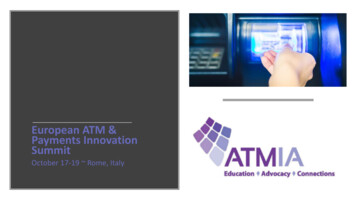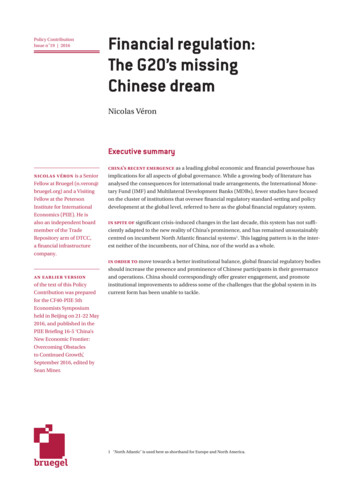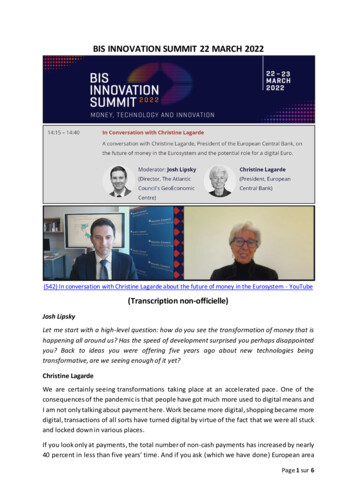
Transcription
BIS INNOVATION SUMMIT 22 MARCH 2022(542) In conversation with Christine Lagarde about the future of money in the Eurosystem - YouTube(Transcription non-officielle)Josh LipskyLet me start with a high-level question: how do you see the transformation of money that ishappening all around us? Has the speed of development surprised you perhaps disappointedyou? Back to ideas you were offering five years ago about new technologies beingtransformative, are we seeing enough of it yet?Christine LagardeWe are certainly seeing transformations taking place at an accelerated pace. One of theconsequences of the pandemic is that people have got much more used to digital means andI am not only talking about payment here. Work became more digital, shopping became moredigital, transactions of all sorts have turned digital by virtue of the fact that we were all stuckand locked down in various places.If you look only at payments, the total number of non-cash payments has increased by nearly40 percent in less than five years’ time. And if you ask (which we have done) European areaPage 1 sur 6
consumers what they would prefer in terms of payment, they generally prefer cashless meansof payment and this is about 50% of them. Four years ago, it was a little over 40%. So, if youstart from what is the demand, what do people expect, it is predominantly cashless payment,digital payment and transactions on internet. There is a real push for those involved inpayments to go in that direction.Josh LipskyI want to speak a little bit about central bank digital currency. Do you think central banks aremoving quickly enough, given the point you just made, and the advancements that arehappening in the private sector? Chair Powell often says it is better to have it right than haveit first. Is that a sentiment you agree with?Christine LagardeI think that sentiment is changing around the globe. But first let us look at what we have. Ninecountries currently offer CBDC. If you look, within the BIS, at the number of central banks thatare looking at CBDCs and have begun to do some research, it is nearly 90 percent of total GDP.More than 80 national central banks are actively looking into this.I would argue that central banks have been a bit slow to begin with. But now, there is realpressure coming from (1) the customer base that we were discussing earlier, (2) thecompetition that we have seen in action over the last few years and (3) public authorities. Thefact that US President Biden has signed an executive order asking players and authorities tofocus on this is a good indication that YES, there is urgency and we need to do real solid workto respond to the needs that are out there.Josh LipskySpeaking of the needs that are out there, I want to talk about some of the trade-off when itcomes to digital assets, and I am thinking now about the crisis that is a front and center of allof our hearts and minds, the war in Ukraine. Is there a risk that these technological innovationscan be used to avoid lawful actions like sanctions, and, from a central bank perspective or froma broader regulatory perspective, what do you think about those challenges?Christine LagardeLet me distinguishing three categories of products that we are talking about here.Category one: the CBDCs developed by sovereigns and that are probably the safest, surest,cheapest and most protective way of having a fiat currency that is guaranteed by thesovereign.Category two: the stablecoins, which certainly are not as reliable, do not benefit from theguaranteed deposit, and are at risk of potential run (a third of which has actually disappearedin the last few years).Page 2 sur 6
Category three (which is the one that I am most concerned about in the context of what ishappening in Russia): the crypto assets. They are not a currency, they are not a means ofpayment, but they are certainly being used as a way to try to circumvent the sanctions thathave been decided by many countries around the world against Russia. A specific number ofplayers, either individuals or corporates, are obviously trying to convert their rubles intocrypto assets. In Europe, we have taken steps to clearly signal to all those who are exchangingtransacting, offering services, in relation to crypto assets that they are being accomplices totrying to circumvent sanctions that are otherwise applicable to the number of people that Ihave referred to earlier.So, are crypto assets a threat? Yes. Has it been a threat in the past? Yes, because when youlook at a lot of the dubious transactions that are taking place, very often you find some cryptoassets (I will not mention any names, but we know what we are talking about), and when yousee the volumes of rubles into cryptos, it is clearly rising.Josh LipskyLet us talk about CBDC and the digital euro project. Can you share with us the key drivers thatled you and the ECB to pursue the project and where the status is right now of the digital euro?Christine LagardeWe decided that we should move ahead studying CBDC a little more than two years ago, andit was prompted by three elements: First, customer's demand, for the reasons that I mentioned earlier: more non-cashtransactions, desire to go digital on the part of customers (not just young customers butalso more experienced ones).Second, competition threat: when Facebook (now Meta) decided to push the boundarieswith its Libra (subsequently renamed Diem, which has now vanished a little bit), that wasregarded as a potential threat and triggered the desire to respond.Third, the advance by some national central banks around the world with their project.Here, the PBoC comes to mind because China was ahead of the game in terms ofexperimenting, piloting, and structuring their CBDC.With these three elements, we decided that we could not just risk being behind the curve andthat we needed to move full speed ahead. That means that for two years we identified issues,we worked hard and presented the project to the Governing Council of the ECB. They gavethe “go ahead” to go into use cases, technology choices, governance, platforms, and that iswhat is going on. It started in October 2021 and it is a two years journey before we can actuallymove to the last phase, which will be experimentation and total implementation within theeuro area.So, we are on time and on budget. The ultimate decision to actually launch will be made bythe Governing Council. I would not prejudge the decision, but it is heading in that direction.Page 3 sur 6
Josh LipskyThat is an exciting development. Of course, we will be paying close attention to the progress.I want to ask about stablecoins and their relationship with CBDC, a digital euro. Sometimesthis is framed as an “either or” choice. We are having this conversation now in the US. Do yousee it that way, or do you see a digital currency ecosystem that can coexist and be healthy withstablecoins and central bank digital currency?Christine LagardeII do not see it as an “either or” choice. I think that they can certainly coexist and from ourperspective, CBDCs and sovereign currencies will not go, because they are the anchoringfactor in the world of currencies. What matters is whether people have the confidence that aeuro is a euro, or that a dollar is a dollar, or that a renminbi is a renminbi.If you have a stablecoin, maybe there is a one-to-one conversion from that stablecoin into fiatcurrency. I say “maybe” because we have seen instances, when the regulator checked intowhether or not there was this one-to-one guarantee, where there was not this guarantee andthe assets against these stablecoins were not tantamount the volume of stablecoins incirculation.So, there will be stablecoins and there will be a desire by some to leverage their respectivenetworks, their respective platforms or their respective payment systems, in order to moveinto that activity. But I am convinced that sovereign currency in the form of CBDCs willnecessarily at least coexist with those stablecoins, because they are the anchor associatedwith safety, solidity, security, and they benefit the confidence that is often associated with thefinancial national institution such as a central bank.Josh LipskyNow, let us talk about privacy. The ECB has identified strong privacy protections as one of thekey features for a digital euro. The FED said the same in their discussion paper last month andas you mentioned, President Biden's executive order on digital assets also highlighted theseissues. So, my question is about transatlantic cooperation. I know that a lot of work alreadygoes on through the G20, the BIS, and other for a. Is there more that could be done betweenthe world's largest central banks (the FED, the ECB ) on experimentation, because there is somuch mutual interest in designing these currencies with the right protections?Christine LagardeTwo points in response: First, the reason why we focus a lot on privacy has to do with the desire that people haveexpressed when surveyed. They do not necessarily want the transactions to beanonymous, and they can understand that because of AML/CFT considerations, a certainPage 4 sur 6
degree of intrusion is acceptable. So, totally anonymous not necessarily, but a completerespect of their privacy, absolutely. That came as their first concern when we consultedand surveyed client groups.Together with privacy, what a central bank can procure is the non-monetization of data.That is a very strong distinguishing feature between stablecoins provided by Meta, PayPaland others, and the digital currencies that central banks can offer to their citizens, becausecentral banks are not in the business of monetizing data. They can protect privacy and thedata of those that use central bank digital currencies. Second, in the field of data there is a degree of asymmetry between Europe and the US.There is far more protection in Europe than in the US, and the GAFAMs are not toopleased. They have lobbied extensively, in Brussels and in other places, to try to reducethe level of protection, to make exchange of data much more fluid and without restrictionsfor the purpose of monetization.The beauty of an organization like the BIS is that it brings together all players in focusgroups amongst people who really speak the same jargon and can focus on the keypriorities. I very much hope that thanks to the BIS, we central bankers can come togetherand have a sufficient common denominator in terms of respect of the privacy of citizens.I can see why Google, Amazon, Facebook (Meta) would want to lobby against it, but notcentral banks.Josh LipskyYou have spoken about confidence in money and I wonder about how you approach people inthe eurozone who say “yes we understand the outreach and the intent” but still may not haveconfidence as these innovations come. How do you express what is happening in thetransformation of money at a broader level?Christine LagardeI will give you a very practical, down to earth, example of what currencies mean and whetherthere is a symbolic force behind it, as well as a transactional value means of payment. We arecurrently trying to help Ukrainian refugees to access hard currencies like the euro despite thefact that their currency (the Hryvnia) has no exchange value at the moment becauseconvertibility has been suspended.We see these refugees crossing the borders from Ukraine to Slovakia, Hungary, Poland orvarious neighboring countries with plastic bags full of banknotes. And the incredulity theyhave when they are told that they cannot exchange their currency (which they think isassociated with a real value) against the euro is a vivid example of how much trust there is incash and in a currency. It is the expression of sovereignty, but it is mind-boggling to see howmuch confidence there is. So, to those who say “there is a change of attitude towards cash,towards money”, I say “maybe”, but I am not so sure.Page 5 sur 6
Josh LipskyOn the digital euro itself, what are you thinking in terms of the possibility for monetary policyor do you see it more as a fiscal tool or is it both?Christine LagardeWe are not we are not working on digital euro to have a new monetary policy tool, nor toeliminate cash. We are working on digital euro for five key reasons. First, we believe that it would be faster, easier, cheaper and more secure across the wholeEurope. We know for instance that the Europeans are paying 1.4% of GDP for paymentservices, and that can go down.Second, we want to make sure that central bank money remains accessible and as theworld becomes more and more digital, we have to find a way for that central money, whichis totally safe, to remain accessible.Third, we believe that a digital euro would safeguard financial stability and monetarysovereignty. By being ahead of the curve, we prevent other players -whether from theprivate sector or from another country- to take the “winner takes all” advantage.Fourth, a digital euro would improve inclusion. Even in Europe, we have about 5% of thepopulation that has no bank account and walks around with cash. For safety reasons andparticularly to protect women who are plenty in that category, that is an inclusive tool;Fifth, to respond to the people's urge for protection of their privacy and security of theirdata.Josh LipskyThank you for clarifying the ambitions of the digital euro, since what we hear from centralbanks all over the world is often confusing.Final question: looking forward five years’ time, where will the world be in terms of digitalassets and of CBDCs?Christine LagardeFive years ahead, many of us will have completed the project, will be in a position or will havelaunched their digital currencies. We will have done enough good work so that thosecurrencies are convertible easily. We will have worked hard on our payment systems so thattransfers and settlements can be organized in a safe, secure and fast way (faster than now)between central banks, between central banks and commercial banks, but also betweencustomers and commercial banks. The fees and earnings by some will have declined to thebenefit of better services and happier customers.Josh LipskyThat is an optimistic note to end. President Lagarde, thank you for sharing your insights, thankyou for your leadership on this issue and so many issues across the world.Page 6 sur 6
BIS INNOVATION SUMMIT 22 MARCH 2022 (542) In conversation with Christine Lagarde about the future of money in the Eurosystem - YouTube (Transcription non-officielle) . If you look only at payments, the total number of non-cash payments has increased by nearly 40 percent in less than five years' time. And if you ask (which we have done .

